Marilyn Hamilton
Abstract
This article explores and seeks to answer the question Where are the Women in the Integral movement? The author utilizes the principles of “Five Deep” exploration from Beck and Spiral Dynamics along with Wilber’s AQAL model to explore circumstances that, she proposes, may have produced a mismatch in stage development between women and men. With reference to Baron-Cohen’s notion of “Essential Difference” the author will also offer an evolutionary explanation as to where the integral women are now and why/how women’s spirit, which has historically risen in times of world crisis, may be rising once again.
In answering “Where are the Women? “, the author explores five strata in the gender landscape: the horizontal strata of behaviors and actions; the vertical strata of structures and stages; the cultural strata; and the psychological strata and puts them all into the context of whole person epistemology and co-created life conditions.
The Horizontal Strata of Behaviors and Actions
Type tends to be looked at in terms of absolutes and/or polarities rather than in terms of continua. The neuro-biological research of Baron-Cohen, proposes that men’s and women’s brain/minds are characteristically differentiated. Men tend to have systemizing minds and women tend to have empathizing minds but both expressions are situated on continua from weak to strong.
The Vertical Strata of Structures and Stages
With regard to the vertical stages of humankind’s evolution, the author proposes that men and women on the path of complexity development have become mismatched in their consciousness development (Beck & Cowan, 1996). The author also explores the possibility of overcoming this mismatch in consciousness, which she argues may be genetically rooted.
Cultural Strata
In locating a place for women in the four horizontal quadrants of reality, the normative lens has leaned towards the cultural quadrant, the space of relationships and family. Ironically this has frequently been explained by women’s visible biological sexual traits (the bio-physical quadrant) that enable human reproduction and child and family care and thus gives them value to men.
This normative lens is in part the result of Structural organizing principles that have allowed humans to propagate over larger and larger spatial and time horizons and arises from men’s drive to dominate the intentional and social quadrants with their greater physical strength. As men’s activities have expanded the space/time horizons of human existence into wider geographic territory, men’s views of the world have come to dominate cultures, relationships, philosophies, religion, politics, and education (in all of the four quadrants of reality). Thus largely women’s views and behaviours are invisible to men’s ways of knowing and because of this blindness a block to the evolution of the human species exists.
The Psychological Strata
Women don’t trust to let go of personal and cultural structures because of fears from the dominator culture (Cohen & Debold).
The Wilber-Combs Lattice (Combs, 2002) that correlates states with stages, reveals the intersection of the vertical stages of structural development with the horizontal stages of states. In theory these are available to all people – but in practice, the author proposes that gender types set us up to differing preferences and capacities that give us different abilities to know life.
In the differentiation between each of the eight AQAL epistemological zones (Wilber, 2006), the author proposes women with predominantly empathizing brain/minds are predisposed to know the world in terms of interior ways of knowing. Men with predominantly systemizing brain/minds are predisposed to know the world in terms of exterior ways of knowing. The author speculates that the differentiation between women’s and men’s predominant ways of knowing is a survival habit that is as old as the universe (H. Abrams & Primack, 2008). This implies that when one strategy related to a polarity fails to enable survival, connection and reproduction (the basic characteristics of life), the species, can cycle back in the direction of the opposite polarity.
Co-Created Life Conditions
At chaotic times, the author proposes that women, individually and collectively, have peak experiences that give them insight about what to do, change, be, have; that alongside threatening life conditions, give them an emotional courage to actualize change. This then releases an energizing spirit that saves their family, clan, city, nation, etc. In the deepest, darkest hours of human need, women’s survival instincts rooted in interior ways of knowing leapfrogs over the barriers of old [male dominated] structures and blasts open new paths to new levels of complexity.
Where are the women? They are gaining the courage to emerge from tens of thousands of years of structural/dominator subjugation and competition with women that has held them back. Ultimately, they are becoming the Sages shape shifting not just women, but the direction of the human species
Where are the Women? Saging the Invisible into the Visible
Where are the women? Leading lights of the Integral Movement have all asked this question in the last few years (Cohen & Wilber, 2007; Debold, 2005a, 2005b). When I first heard the question, I was viscerally affronted. I knew intuitively the women we searched for were all around us. They were us. But they were invisible to those who were looking and I couldn’t find the way to explain my knowing.
Finally, the veils dropped and I was able to see why women were seemingly invisible to leaders in the Integral Movement. This article is an attempt to offer an explanation of where the women are and why it is difficult to see them.
The Horizontal Strata of Behaviors and Actions
Where are the women? It is interesting that in the integral exploration of verticality and four quadrant horizontality, the consideration of “Type” has been sidelined or subjugated to almost a subordinate discourse. Examples of type are often listed as the hard-wired characteristics of gender, race or disposition. Type tends to be looked at in terms of absolutes and/or polarities. It is less often discussed in terms of continua, or even less in its ability to adapt (as epigenetics now reveals (Lipton, 2005)). Because of the absolutistic framing of gender it is rarely considered in terms of characteristics of the human species that enable survival of the species. So men are irretrievably men and women are inescapably women.
However, science keeps revealing to us that what we label as gender is a series of continua that are perhaps characteristics of the greater universe embedded in our beings. Wilber (Cohen & Wilber, 2007) and Howard (Howard, 1994) point out the characteristic drivers of testosterone (typically high in men, low in women) and oxytocin (typically high in women, low in men) lead to measurably different behaviors. If either male or female bodies are injected with hormones typically related to the opposite sex, their behaviors change to that of the opposite sex (Howard, 1994; Schultz, 2005).
Another hint of the malleability of our genders comes from the secondary research of (Moir & Jessel, 1991) and (Howard, 1994) and the primary research of (Baron-Cohen, 2003), all of whom propose that men’s and women’s brains/minds are characteristically differentiated. Baron-Cohen describes men as tending to have systemizing minds and women tending to have empathizing minds. These authors trace the roots of these differences to the in utero baths of testosterone that change the gender of the fetus from female to male. However, Baron-Cohen’s research also suggests that it is possible to have a female gendered body and a male systemizing mind (and vice versa). Thus it seems that we have four major brain/body combinations: systemizing/male; empathizing/female; systemizing/female; and empathizing/male. Schultz (2005, pp.19-43) even observes that multiple aspects of the “traditional” male and female brains can be symmetrically linked in the typical male and female bodies or crossed-over in multiple ways (connections between brain areas, connectivity/compartmentalization, multi-thinking, plasticity). On careful consideration it is not difficult to see those of us who “embody” and “enmind” polarized combinations of key traits and all their gradations in between.
It would appear that research such as Baron-Cohon’s and Schultz’s demonstrates the link between typology and behavior and points to the distinct possibility of a species mind; that can be appreciated through not only the hormone driven brains of systemization or empathy, but the hormone neutral brain/mind that can embrace both capacities.
In summary, I am curious if integral men cannot see integral women, because, we tend to see the world through our own typology and therefore we cannot recognize the behavior and actions of a different type? This is an old argument that is just based on horizontal trait theory – but may well still be in play.
The Vertical Strata of Structures and Stage
Where are the women? If we want to get below the observation of horizontal behaviors and actions, we need to step into the vertical territory of developmental systems, structures and stages of the human species. This theory, mapped by numerous knowledge domains (Beck & Cowan, 1996; Eisler, 1995; Graves, 1971, 2003, 2005; Wilber, 1995, 2000, 2007) may indicate that women have gotten locked into habits of traditional structures, where to survive in a world where they are bio-physically weaker and vulnerable, they have learned to use their sexual power to counteract men’s physical strength.
Craig Hamilton (Hamilton, 2009) points out that our reptile brain controls our sex drive. But the combination of life conditions and biology have created structures where humans have species-selected so that males driven to have sex and/or impregnate women have been selected along with women who have been selected to be choosy about who they have sex with and who help raise their children. In both cases the biological selection has continued to accentuate different preferences that became effective adaptive strategies for perpetuating the species.
Perhaps women have learned to survive by being competitive amongst themselves in order to gain the protection of men and the advantage of reproductive favor (Diamond, 1992, pp. pp.79-84)? Andrew Cohen (2007) has noticed that these deference habits to men and competitive habits to women are so deep (perhaps genetic he surmises) that when women come together for group meditation, their fear of structural dominance prevents them from entering the deepest meditative experience of easily “being” together in a state of non-dual awareness.
Cohen has commented that this survival strategy even seems to lock women into an ego state that is highly resistant to letting go; that women seem resistant to release from old structures that although they visibly subjugate women, allow women to hold onto their invisible “souls”. (The recent cases of women abducted and held captive for 24 years (Fritzl) and 18 years (Dugard), but who bore children and created a home for them under dire conditions of captivity, seem to bear out this hypothesis (Laidlaw, 2009)). It seems that women will behaviorally shape shift in order to adapt to life conditions that are visibly not in their favour to protect the survival of their and their children’s bio-physical lives. Debold (2005a) supposed that this might be built into women’s very evolutionary roots.
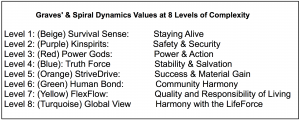 In 1971, Clare Graves (Graves, 2003, pp. 52-52) built his theory of the levels of human existence around data that demonstrated the degrees of neurological development in human systems adapted to the environment or life conditions (LC) and the environment adapted to changes in human systems. Figure 1 illustrates (using the Spiral Dynamics (1996) colours) the eight systems that he mapped. Graves identified that human systems alternated between express self systems (those in the ascendancy pattern, Levels 1,3,5,7 or beige, red, orange and yellow in Spiral Dynamics terms) and sacrifice self systems (those in the plateauing or adjusting systems, Levels 2,4,6,8 or purple, blue, green and turquoise in Spiral Dynamics terms) . These systems became progressively more complex as they evolved over time. Graves identified eight levels with a notable shift in complexity after Level 6, such that he considered he actually had found two tiers, with Levels 1-6 representing Tier 1 and Levels 7 and 8 representing Tier 2. He called the intertwined people and environment strands a double helix. Graves identified key values associated with each level of human existence as noted in Sidebar 1.
In 1971, Clare Graves (Graves, 2003, pp. 52-52) built his theory of the levels of human existence around data that demonstrated the degrees of neurological development in human systems adapted to the environment or life conditions (LC) and the environment adapted to changes in human systems. Figure 1 illustrates (using the Spiral Dynamics (1996) colours) the eight systems that he mapped. Graves identified that human systems alternated between express self systems (those in the ascendancy pattern, Levels 1,3,5,7 or beige, red, orange and yellow in Spiral Dynamics terms) and sacrifice self systems (those in the plateauing or adjusting systems, Levels 2,4,6,8 or purple, blue, green and turquoise in Spiral Dynamics terms) . These systems became progressively more complex as they evolved over time. Graves identified eight levels with a notable shift in complexity after Level 6, such that he considered he actually had found two tiers, with Levels 1-6 representing Tier 1 and Levels 7 and 8 representing Tier 2. He called the intertwined people and environment strands a double helix. Graves identified key values associated with each level of human existence as noted in Sidebar 1.
While Graves research was ground breaking, he did not differentiate between men’s and women’s development. He basically proposed that if (taking a plan view of his helix) one examined the starting conditions of this relationship, that the life conditions and the human systems were matched with one another, at Level 1 (Beige) as shown in Figure 2.
However, since Graves proposed that people change the LC, at some point the two become mismatched and it is this tension that triggers the development of human systems to the next level of complexity as shown in Figure 3 where Level 2 Purple Life Conditions emerge because of Level 1 Beige human behaviours.
As a result over time we can see how these interacting systems contribute to the trajectory of human development (per Figure 1). Graves was seminal in his thinking not only because he dared to put forth a complexity view of human development, he also observed that human systems development embraced biological, psychological, social (and cultural) qualities (Graves, 1974).
With his never ending interest in the human condition, I am curious that if Graves had the science we have today that reveals the differences in male and female brains and bodies if he would have differentiated their evolutionary unfolding? I can only conjecture that he would have learned from the new sciences and propose that his theory still offers a backbone for explaining what has happened as the species adapted for survival purposes. In order to see this, I propose a triple helix that differentiates between men’s and women’s development with their LC. Figure 4 shows a triple helix that illustrates the simultaneous adaptation of the two genders.
Once we introduce the mismatching of environmental conditions to the two genders, who had different capacities for adaptation, we open up the possibility that the two genders did not adapt simultaneously. Figure 5 illustrates what would have happened if men adapted ahead of women (from Level 1 beige to Level 2 purple) and Figure 6 illustrates what would have happened if this lag continued to play out (from Level 2 purple to Level 3 red) .
Other variations on this possibility include the scenario where women develop first (see Figure 7). However it is the research of Riane Eisler discussed below that seems to bear out that the Figure 5 and 6 scenarios are what has played out in human history – where men from the Level 3 (Red) Kurgan culture overran Level 2 Old European cultures, subjugating the Level 2 women to their Level 3 power.
It should be noted that theoretically a third scenario could emerge where the men, women and Life Conditions are all differentiated. This could happen at times of punctuated equilibriums (such as we are experiencing now), where new conditions arise that are not simply the result of local human interaction on the environment – but of extraordinary elements (such as the imposition of the developing world on the developed world, natural disasters like volcanic eruptions or extraterrestrial events like meteor assaults) that interrupt the natural (and historical) relationship of the triple helix. In such cases we should expect to find discontinuities such as illustrated in Figure 9. It may well be such discontinuities are what call forth the extraordinary capacities of women on behalf of the survival of the human species discussed below.
Beck (2000; Beck & Cowan, 1996; Beck & Linscott, 2006) notes that men in orange and green (and I would add half-awakened yellow/turquoise) take flagrant advantage of women in blue, red and purple. Eisler (1995) proposes that this condition arose in the shift of power from Old European matrilineal cultures to Kurgan ways. This is easy for men to do, not only because the men’s orange/green structural development is more complex than women in blue/red/purple, but so is their physical, cultural and social power. Also the mere demographics of the world mean that the sheer number of women at blue/red outnumbers those at orange/green. So the pool of women from which men choose or relate is naturally larger at blue/red. And under these conditions, where men and women are out of step with each other on the path of vertical development the dilemma of mis-matching of men/women consciousness development is perpetuated.
In summary the structures and systems that seem to have differentiated men and women appear to have emerged from the triple helix of their bio-psycho-cultural-social patterns and life conditions. We appear to have entered an age of possible punctuated equilibria that are creating conditions for women to take a quantum leap beyond the structures that have subjugated them to men and made them competitive with other women.
The Cultural Strata
Where are the women? The lens for locating women in the four quadrants (bio/It-psycho/I-cultural/We-social/Its) of reality is normally weighted in the invisible cultural quadrant, the “We” space of relationships and family because so much of women’s contribution to the species has been to this quadrant of reality.
Ironically women’s capacity for family and relationships is frequently explained by her distinguishing characteristics in the visible biological “It” quadrant. They are explained by her womb, her oxytocin, her embodiment of the human reproductive process. Women are named as the embodiment of the human condition; whereas men are given the advantage of the “enmindment”.
Yet, as Debold points out gender and its study, holds the secrets to life – what the study of complex adaptive systems identifies as the three characteristics of life are embraced completely by gender: survival, connecting with the environment and reproduction.
As noted above, several authors (Diamond, 1992; Hamilton, 2009; Howard, 1994; Moir & Jessel, 1991) paint the compelling picture that women will do whatever it takes to survive, connect or relate and reproduce – it is indeed in their genes, because they are alive and all life has this generative impulse.
It is ironic that men are given the qualities of enmindment and structural development – the two other quadrants of the “I” and the “Its” (in the integral model) that cross those qualities of women (as noted above). But the combination of invisible conscious awareness and visible (manifest) structural development has given men an advantage in the span of history that dates from the agricultural era to the industrial era – a span of about 5-10,000 years (Diamond, 1992; Eisler, 1995). Men’s visible structural dominance has created the hierarchies that have organized and controlled the world and its resources for three of the five significant stages (Levels 3, 4 and 5) of the lifespan of our species. The amassing of power and resources in those stages is equal by some estimations to 90% of the power in the world today (Beck, 2000, 2001, 2002; Wilber, 1996, 2000).
It is natural that such dominator hierarchies (Eisler, 1995) have emerged in the life conditions of our species – it has provided organizing principles that have allowed the species to propagate over larger and larger spatial and time horizons. But it is also these conditions that have allowed men’s views of the world to dominate cultures, relationships, philosophies, politics, education and indeed most walks of life (in all of the four quadrants of reality: I, Its and We, It). Thus the external public cultural power has been in the hands of men – though it has often been observed that the internal private cultural power of the home has remained the purview of women.
In summary, male dominated cultures have supported and/or given birth to the structures that have created limiting conditions for women in public time/space. Both men and women now need to notice the limitations that no longer serve species’ evolution. They need to go beyond the collectively held beliefs that hold women in cultures because of men’s valuing of women’s biology in service to their structures, into new cultural forms that recognize the dual role of women and men in creating a new tomorrow.
The Psychological Strata
Where are the women? Eisler, Wilber, Debold and Cohen’s deep and honorable quests into the nature of structural and cultural stages explains much of the visibility and invisibility of women in the evolutionary journey. However, despite being adept at state experience, they have skipped lightly by the phenomenon of state stages in their dialogues. Nevertheless, Debold has pointed out that in times of great human need a fire has burned through women that has changed the course of history time and again (Debold, 2007). But Debold’s great conundrum is, after each of these occurrences, why did women return to the seeming invisibility of the home? Why did they not hold onto the power that they used to shift the world?
I believe that state stages lies at the heart of explaining where the women went – both now at this time and historically when women have enabled, embraced and evolved (the human) spirit.
It does not seem accidental to me, that a woman, Evelyn Underhill identified the stages of spiritual states when Fowler was identifying the stages of spiritual structures (Fowler, 1981). Or that a woman, Carol Gilligan identified women’s different moral development as compared to Kohlberg men’s moral stages (Gilligan, 1982). So it breaks open the pattern, that a man, Ken Wilber (Wilber, 1995, 2001, 2006) has pondered the reality and value of the subjective realm of state experience and insisted that it deserved equal valuation and consideration as the realm of developmental structures. [i]
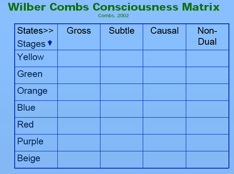 The Wilber-Combs Lattice (Combs, 2002) that correlates the states with the stages, reveals to us the intersection of the vertical stages of structural development with the horizontal stages of states. In theory these are available to all people – but in practise, I propose that our gender types set us up to both preferences and capacities that give us different abilities to know life.
The Wilber-Combs Lattice (Combs, 2002) that correlates the states with the stages, reveals to us the intersection of the vertical stages of structural development with the horizontal stages of states. In theory these are available to all people – but in practise, I propose that our gender types set us up to both preferences and capacities that give us different abilities to know life.
Wilber takes us deep into understanding the relationship between states and structures when he turns to ways of knowing – the epistemologies – by which we know the world (Wilber, 2006). He creates the double zones within each quadrant – the interior and the exterior, individual and collective ways of knowing: subjective, intersubjective, objective and interobjective realities.
The interior ways of knowing are defined as: phenomenology, autopoiesis, hermeneutics and social-autopoiesis (Wilber’s zones 1,3,5,7). The exterior ways of knowing are defined as: structural, empirical, ethnographic and systems (Wilber zones 2,4,6,8). Wilber implies that the interior and exterior epistemologies are so distinctive from one another, that neither can see the other, nor prove the other. Yet each discloses a vitally important truth that is not otherwise knowable and contributes to our understanding of reality. Each truth is verifiable, relevant and trustworthy, but partial.
It is the differentiation between each of these eight quadrant zones that brings me now to propose an explanation for where the women are. People with empathizing brain/minds are predisposed to know the world in terms of interior ways of knowing. This tends to be largely (but not exclusively) female body/minds. People with systemizing brain/minds are predisposed to know the world in terms of exterior ways of knowing. This tends to be largely (but not exclusively) male body/minds.
The interior ways of knowing are not only interior but mostly invisible by definition. They have been discounted and devalued by the exterior ways of knowing and those (men) who have had the power to give exterior ways of knowing primacy. At first tier levels of development exterior ways of knowing have also favored the right hand quadrants’ visible engagement with the world. Thus women’s ways of knowing have not only been disempowered but invisible because exterior epistemologies don’t admit them and women have protected the secrets of interior ways of knowing as a power that allowed them to “protect their souls” and shape-shift when the survival need arose.
In summary, men’s ways of knowing have failed to appreciate women’s ways of knowing, thereby causing individuals and the collective alike to ignore, discount and be blind to other perspectives that have actually acted on behalf of the survival of the species.
Co-Created Life Conditions
Where are the women? The epistemological polarities noted above respond to Debold’s question “Why have the women who evolved consciousness, at different times in history, seemingly always have gone back to the home?” (Debold, 2005)
I am speculating that the differentiation between women’s and men’s predominant ways of knowing is a survival habit that is as old as the universe. The polarities between energy and matter, yin and yang, ebb and flow, have called forth survival patterns that are most resilient (and long lasting) if the manifest reality has a built-in mechanism for change or even transformation from the invisible to the visible (See Footnote 1 below (N. E. Abrams & Primack, 2006). So that when one strategy related to a polarity fails to enable survival, connection and reproduction (the basic characteristics of life), the species (as a manifestation of reality) can cycle back in the direction of the opposite polarity.
Thus when we look back at human history it is easy to spot the evolution of complexity in our relationships, families, clans, organizations, settlements and nations and point to the structural stages that identify the levels of bio-psycho-cultural-social emergences. However, what is much less visible from the safety of our “balcony” is the breakdowns, dissonances, discontinuities and pre-bifurcation points (Eisler, 1995, p. p. 47) where structures seemed untenable, chaotic and impossible. I propose that Debold has identified that precisely at those times the women’s ways of knowing have come to the rescue of the species.
Because empathetically wired women are bio-physically predisposed for high state experiences, (perhaps triggered by threats to them, their children and their household’s survival), women transcend their competitiveness with other women and subjugation to men, and at these times of high species-need, women individually and collectively gain deep insight from interior ways of knowing. They have peak experiences that give insight about what to do, change, be, have, that along with the threatening conditions give them an emotional courage that releases an energizing spirit that saves their family, clan, city, nation, etc. They literally rise to the occasion and lead in a new way, with an undeniable fierceness that all recognize as the survival impulse. First it is the other women who recognize themselves in the honoring of any interior (and invisible) ways of knowing who join in the wave of shifting expression. And then it is the men who cannot deny the energy shift that the force of the women’s collective ways releases across the landscape. That is how and why women literally change history at pivotal moments. In the deepest, darkest hours of human need women’s survival instincts of interior ways of knowing leapfrogs over the barriers of old structures (including egoic ones) and blasts open new paths to new levels of complexity. As Wilber notes often, the practise of advanced state stages, enables the advancement and acceleration of advanced structural stages. When all the structural ways of knowing, being, doing and having in the world fail the species, it is at these times, empathizing women who tend to naturally have access to the interior states, are the first to notice and commit to, what must change for survival.
In the past, only when the state experience has been interpreted by a structural consciousness that is sufficient to save the family/species have women returned to the safety of home. By that time the shift has caused the human family that women have touched to transform to a level of complexity that human life needs to support itself under new life conditions (and which level of complexity eventually transcends and includes all the levels that have gone before).
Why have women traditionally returned home after such exciting, seemingly empowering consequences of their actions and behaviors?? Because until the last three decades that was the only place their protection for survival existed. The rise of the information age has changed the relationship between structure and state, between men, women and life conditions – and thus all the relationships in the world — so now women (at least in the developed world) are sensing that once again their ways of knowing are deeply needed to solve the world’s survival problems. (Meanwhile women in the developing world may well still fear for their safety and continue to defer to men and compete with women.) But for the first time in history, the women in the developed world are noticing that they have the power to tap into state stage wisdom. In an era where so much that is invisible technologically has been released in service to human survival and evolution, perhaps women are sensing a less threatening environment where their interior ways of knowing may also be made more visible, more available and more accepted? Perhaps now is the time to move beyond the disabled nation structures and state-changing monasteries of the past into an entirely new state for the human species where women can join men in new ways? Eisler calls such a possibility a partnership. Cohen refers to it as a new human consciousness.
I propose revelations from the interior ways of knowing are flowing strongly through women today. And the women who are leading the charge with honoring those ways of knowing (eg. Jean Houston, Barbara Marx Hubbard, Nancy Abrams, Hazel Henderson, Nancy Roof, Elizabeth Debold, Diane Hamilton, Elisabet Sahtouris, Meg Wheatley, Elza Maalouf ++++) are releasing a quickening of the human spirit that is spanning the globe. In the information age, it is precisely the interior ways of knowing that reveal to us the new realities of the (largely invisible) universe. They make visible the invisible and enable the emergence of global, holarchic, universal and archetypal complexities of Levels 7 and 8 and the higher stages of state consciousness.
Shapeshifting the Species
Where are the women? They are gaining the courage to emerge from tens of thousands of years of structural/dominator subjugation and competition with women that has held them back. They are researching the resilient realities of their particular typologies; they are inventing new structures for human performance; they are creating cultures that believe in perspectives that embrace the invisible with the visible; they are learning the power of their individual consciousnesses; they are grasping the leverage of their collective consciousnesses; and they are linking the interior epistemologies with the exterior epistemologies of the integral realities. Ultimately, they are becoming the Sages shape shifting not just women, but the direction of the human species.
Where are the women? – change your ways of relating to the world and you will find not just the women but the new Sages of our species:
- Look through the epistemologies that women use to relate to the world.
- Recognize and transcend the evolutionary structural boundaries that have privileged dominator cultures, then emerged social networks and now see the new territory that has opened up in the systemic flex-flows of an integral worldview.
- Appreciate the triple helix of the evolutionary trajectory of the species so that you can see how both men and women have co-created each other and life conditions for evolutionary survival, adaptiveness and reproduction.
- Create the conditions of safety so women can let go of old patterns buried deep in their cultures and psyches so they can reconnect with the source of being and becoming and shift from identification with their gender to being fully conscious human beings.
- Appreciate that life conditions vary around the world and each person, family, clan, community, country and geography are co-creating new conditions for our next evolutionary emergence as fully conscious human beings.
Endnote
[i] No doubt it is with deep gratitude that we have to turn to a wife/husband team for an explanation of how the visible gross realm can co-exist with the invisible subtle, causal and non-dual realms of human states. Joel Primack and Nancy Abrams (2006) are telling a new story of human evolution that situates the human condition clearly in the mid-range of all that has ever evolved; in a universe where 99% of all energy and matter are invisible – discovered only in the last decade!! The discoveries of Invisible Atoms, Dark Matter and Dark Energy open up the enormously real possibility that the visible universe which we inhabit is indeed impacted by invisible forces almost beyond our imagining. In this re-framing of the scale of reality, we finally have a glimpse for understanding that state experiences might somehow touch this realm of reality from which we have evolved and are still co-evolving. With the immensity of this reality, perhaps it is now possible to conceive that state experiences are real and that all state experiences (nature, deity, formless or non-dual) can occur at any vertical structural stage of development. Our greatest dilemma as humans is that we have a natural tendency to interpret any state experience at the centre of gravity of the vertical structural stage of development.
References
Abrams, N. E., & Primack, J. R. (2006). The View from the Centre of the Universe: Discovering our Extraordinary Place in the Cosmos. New York: Riverhead Books, Penguin Group.
Baron-Cohen, S. (2003). The Essential Difference: The Truth About the Male and Female Brain. New York: Basic Books.
Beck, D. (2000). Stages of Social Development: The Cultural Dynamics that Spark Violence, Spread Prosperity and Shape Globalization. Paper presented at the State of the World Forum.
Beck, D. (2001). Human capacities in the integral age: How value systems shape organizational productivity, national prosperity & global transformation. Paper presented at the International Productivity Conference. Retrieved March 20, 2007, from http://www.integralworld.net/beck7.html
Beck, D. (2002). Spiral Dynamics in the Integral Age. Paper presented at the Spiral Dynamics integral, Level 1.
Beck, D., & Cowan, C. (1996). Spiral Dynamics: Mastering Values, Leadership and Change. Malden, MA: Blackwell Publishers.
Beck, D., & Linscott, G. (2006). The Crucible: Forging South Africa’s Future (hardcover ed.). Columbia, MD: Cherie Beck, Coera.us, Center for Human Emergence.
Cohen, A., & Wilber, K. (2007, July-September). Women, Enlightenment and the Evolution of Culture. What Is Enlightenment, pp. 54-68.
Combs, A. (2002). The Radiance of Being: Understanding the Grand Integral Vision Living the Integral Life. St. Paul, Minnesota: Paragon House.
Debold, E. (2005a, July – August). Where Are the Women? What Is Enlightenment, pp. 36-42.
Debold, E. (2005b, September-November). Where Are the Women? Toward a New Women’s Liberation. What Is Enlightenment, pp. 34-41.
Debold, E. (2007, July – September). The Fire of Freedom. What Is Enlightenment, pp. 42-52.
Diamond, J. (1992). The Third Chimpanzee: the Evolution and Future of the Human Animal. New York: HarperCollins Publishers.
Eisler, R. (1995). The Chalice & the Blade: Our History, Our Future. San Francisco: Harper & Row.
Fowler, J. W. (1981). Stages of Faith: The Psychology of Human Development and the Quest for Meaning, . San Francisco,: HarperSanFrancisco,.
Gilligan, C. (1982). In a Different Voice: Psychological Theory and Women’s Development. Cambridge, MA: Harvard University Press.
Graves, C. (1971). A systems conception of personality: Levels of existence theory Paper presented at the Washington School of Psychiatry.
Graves, C. (1974). Human Nature Prepares for a Momentous Leap The Futurist.
Graves, C. (2003). Levels of Human Existence: Transcription of a Seminar at Washington School of Psychiatry, Oct. 16, 1971. Santa Barbara: Eclet Publishing.
Graves, C. (2005). The Never Ending Quest: A Treatise on an Emergent Cyclical Conception of Adult Behavioral Systems and Their Development. Santa Barbara, CA: ECLET Publishing.
Hamilton, C. (2009). The Future of God [Electronic Version]. Retrieved August 1, 2009 from http://www.greatintegralawakening.com/craighamilton.html.
Howard, P. J. (1994). The Owners Manual for the Brain: Everyday applications from mind-brain research. Austin, TX: Leornian Press.
Laidlaw, K. (2009). She Has a Real Guilt Trip. National Post, p. A13.
Lipton, B. (2005). The Biology of Belief: Unleashing the Power of Consciousness, Matter and Miracles. Santa Rosa, CA: Mountain of Love/Elite Books.
Moir, A., & Jessel, D. (1991). Brain Sex. New York,: Dell Publishing.
Schultz, M. L. (2005). The New Feminine Brain: Developing Your Intuitive Genius. New York: Free Press, A Division of Simon & Schuster, Inc.
Wilber, K. (1995). Sex, Ecology and Spirituality: the spirit of evolution. Boston: Shambhala Publications Inc.
Wilber, K. (1996). A Brief History of Everything, . Boston,: Shambhala Publications Inc.,.
Wilber, K. (2000). A Theory of Everything. Boston: Shambhala Publications Inc.
Wilber, K. (2001). Marriage of Sense and Soul. New York: Random House.
Wilber, K. (2006). Integral Spirituality. Boston: Shambhala Publications Inc.
Wilber, K. (2007). The Integral Vision. Boston: Shambhala Publications Inc.
About the Author
Marilyn Hamilton PhD, CGA, CSP: is founder of Integral City Meshworks Inc. and TDG Global Learning Connections www.integralcity.com . She is a charter member of Integral Institute, Globe Sustainable City Awards, Centre for Human Emergence: Canada, Canadian Professional Sustainability Institute and Training Trainers for Spiral Dynamics integral. Author of Integral City: Evolutionary Intelligences for the Human Hive (2008, New Society Publishers) Marilyn hosts, applies and teaches Integral City intelligences for designing change in the city that is ecologically informed and operationally integrated with a community of practise in Canada, USA, Mexico, Scandinavia, Europe, Russia, Asia and Australia. Gender, generations and evolution have been themes on which she has recently published.
Contact: marilyn@integralcity.com ; www.integralcity.com ; blog marilyn.integralcity.com; twitter integralcity Integral City Meshworks Inc. Unit 24-4001 Old Clayburn Rd., Abbotsford, BC, Canada V3G1C5; Royal Roads University marilyn.hamilton@royalroads.ca


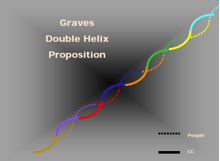

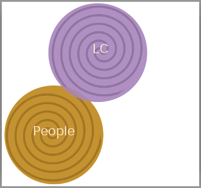
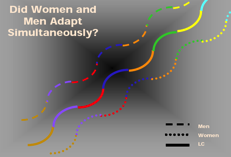
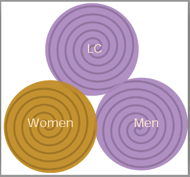
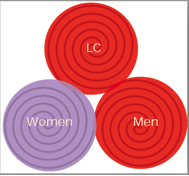
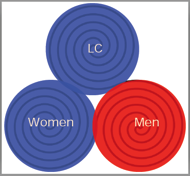
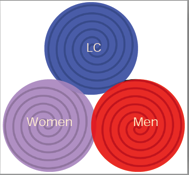
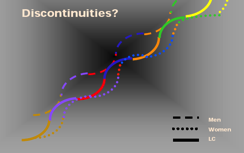
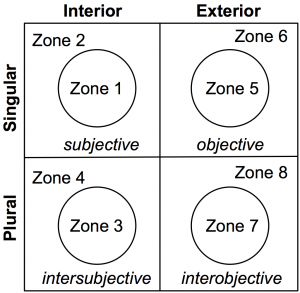
Bravo, Marilyn! Your eloquent words give structure to that deep interior-seated learning/seeking/mulling/doing/waiting I’ve been experiencing. Thank you!
glad it rings true! Why we all feel like we are birthing the species!
Wow! What a well done article. Not only well researched and argued but it added whole new Integral/Spiral learning, for me at least. This could be a 2 day course. Congratulations.
Actually John it’s a 3 day course – it is the core of Quantum Woman II :-). Thanks for your appreciation!
Very interesting article Marilyn, thank-you. I will contemplate more on this. It stirs me. It plunges me into my deep interiors. It summons my inner Woman of Wisdom to draw forth the potential future from the infinite fertile void, but just now, it is inexpressible, as if on the tip of my tongue. Hmmmm…
As this resonates true here for me, what has maybe jut been seen is that in my relationships I am building my own survival mechanism in the continuous discrimination of a strong woman. It feels like I am removing ground beneath her feet in order for her to fly us both to safety as my own round falls away … Interesting, and new!
As this resonates true here for me, what has maybe just been seen is that in my relationships I am building my own survival mechanism in the continuous discrimination of a strong woman. It feels like I am removing ground beneath her feet in order for her to fly us both to safety as my own gyound falls away … Interesting, and new!